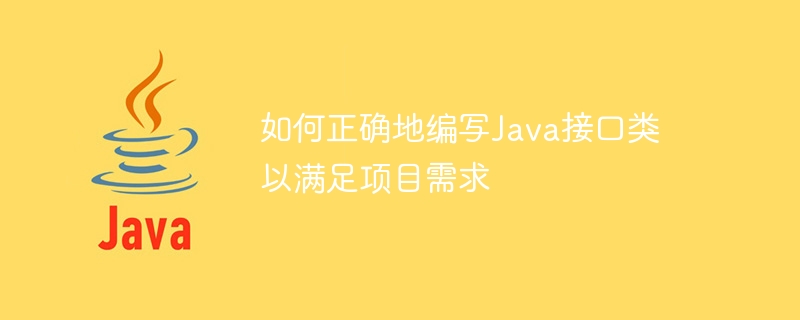

How to correctly write Java interface classes to meet project needs
In Java development, the interface is a very important programming tool that defines a set of methods Specification used to describe the interaction between classes. By writing the right interface classes, we can improve the readability, maintainability, and scalability of our code. This article will introduce how to correctly write Java interface classes to meet project needs and provide specific code examples.
Before writing the interface class, you must first fully understand the project requirements. It is necessary to clarify the role and function of the interface, as well as how to interact with other classes. According to the project requirements, design appropriate methods and parameters, and consider related issues such as exception handling and data verification.
The naming of the interface class should comply with the Java naming convention, use camel case naming, and start with a capital letter I, indicating the interface. For example, if the interface represents user management functionality, it can be named IUserManager.
The methods in the interface are the core part of the interface class. Methods should be clear and unambiguous, describing their functionality and parameters. The method definition should contain the return type, method name, and parameter list, and annotations can be used to provide more detailed instructions.
For example, if the interface needs to define a method to obtain user information, it can be defined as follows:
/** * 获取用户信息 * * @param userId 用户ID * @return User 用户实体类 */ User getUserInfo(String userId);
Constant can be defined in the interface, Used to represent some properties that cannot be modified. Constants should be written in all uppercase letters and underscores, and should be qualified in the interface declaration using the keywords final and static.
For example, if the interface needs to define a constant that represents the user status, it can be defined as follows:
/** * 用户状态:已激活 */ final static String USER_STATUS_ACTIVE = "active"; /** * 用户状态:已锁定 */ final static String USER_STATUS_LOCKED = "locked";
Interfaces can inherit through To establish a relationship, a class that implements an interface must implement all methods in the inherited interface.
For example, if you need to define a user management interface that inherits the user information interface and user permissions interface, you can define it as follows:
public interface IUserManager extends IUserInfo, IUserPermission {
// 添加其他方法
}The interface only defines the specification of the method, and the specific implementation is completed by the implementation class. In the project, one or more implementation classes should be defined for each interface, and specific implementations should be carried out according to different scenarios.
For example, if you need to implement a user management interface, you can write a UserManager class to implement the relevant methods, and use the keyword implements on the class to declare the implemented interface.
public class UserManager implements IUserManager {
// 实现接口中的方法
}Interface design should have a certain degree of flexibility and be able to adapt to changes in project requirements. When writing an interface class, you need to think about various possible use cases and try to ensure that the interface method and parameter design are universal and extensible.
Summary:
Correctly writing Java interface classes is an important step to ensure the quality of project code. When designing an interface, you need to fully understand the project requirements. Naming specifications, method definitions, constant definitions, inheritance relationships, relationships between interfaces and implementation classes, and the flexibility of interface design are key elements that need to be considered when designing interfaces. Through good interface design, we can improve the readability, maintainability and scalability of the project code.
The above are some guidance and specific code examples on how to correctly write Java interface classes to meet project needs. Hope this helps!
The above is the detailed content of Guide to writing Java interface classes: ways to ensure project requirements are met. For more information, please follow other related articles on the PHP Chinese website!
